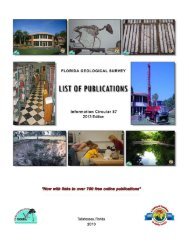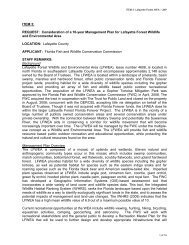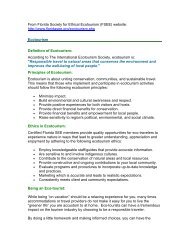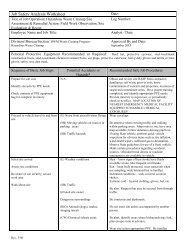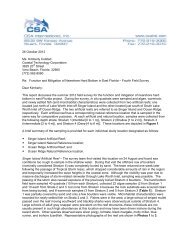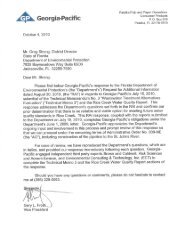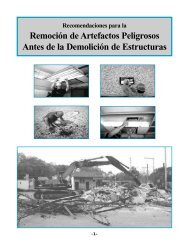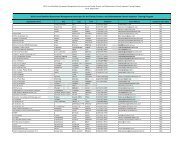A Framework for Coastal Water Resource Monitoring in Florida
A Framework for Coastal Water Resource Monitoring in Florida
A Framework for Coastal Water Resource Monitoring in Florida
Create successful ePaper yourself
Turn your PDF publications into a flip-book with our unique Google optimized e-Paper software.
<strong>Florida</strong> <strong>Coastal</strong> <strong>Monitor<strong>in</strong>g</strong> <strong>Framework</strong><br />
d) Integration and coord<strong>in</strong>ation<br />
Tier 2 monitor<strong>in</strong>g is <strong>in</strong>tended to be both <strong>in</strong>tegrated with <strong>Florida</strong>’s freshwater<br />
Integrated <strong>Water</strong> <strong>Resource</strong> <strong>Monitor<strong>in</strong>g</strong> network (IWRM) and coord<strong>in</strong>ated with the<br />
Impaired <strong>Water</strong>s Program.<br />
The coastal Tier 2 sampl<strong>in</strong>g times and locations will be, to the extent possible,<br />
complementary to the IWRM sampl<strong>in</strong>g schedule to maximize our understand<strong>in</strong>g of<br />
the effects of freshwater flow on the coastal receiv<strong>in</strong>g waters and to help identify<br />
cause-effect relationships between <strong>in</strong>flow<strong>in</strong>g water quality and the receiv<strong>in</strong>g water’s<br />
biological assemblages.<br />
The coastal Tier 2 sampl<strong>in</strong>g will also be coord<strong>in</strong>ated with the 5-yr rotat<strong>in</strong>g-bas<strong>in</strong><br />
schedule of the Impaired <strong>Water</strong>s Program and its ef<strong>for</strong>ts to identify if water bodies are<br />
impaired and to develop Total Maximum Daily Loads (TMDLs) <strong>for</strong> those that are.<br />
The one-year <strong>in</strong>tensive surveys of the coastal monitor<strong>in</strong>g program will be coord<strong>in</strong>ated<br />
to co<strong>in</strong>cide with the year of sampl<strong>in</strong>g and data collection that takes place dur<strong>in</strong>g the<br />
second year of the Impaired <strong>Water</strong>s Program’s five-year rotat<strong>in</strong>g schedule.<br />
3) <strong>Coastal</strong> Tier 3: Site-specific <strong>Monitor<strong>in</strong>g</strong><br />
Tier 3 monitor<strong>in</strong>g is <strong>in</strong>tended to be that which is per<strong>for</strong>med to address site-specific issues,<br />
<strong>in</strong>clud<strong>in</strong>g permit-related monitor<strong>in</strong>g, identification of cause-effect relationships, sources<br />
of impacts, and similar studies, <strong>in</strong>clud<strong>in</strong>g assessment of anthropogenic <strong>in</strong>fluences.<br />
In<strong>for</strong>mation gathered <strong>in</strong> Tier 3 monitor<strong>in</strong>g ef<strong>for</strong>ts that occur with<strong>in</strong> a Tier 2 report<strong>in</strong>g unit<br />
will be <strong>in</strong>cluded among the data analyzed <strong>in</strong> creat<strong>in</strong>g the report card <strong>for</strong> that area.<br />
a) Scale<br />
Determ<strong>in</strong>ed by needs of agency carry<strong>in</strong>g out monitor<strong>in</strong>g.<br />
b) Timeframe<br />
Determ<strong>in</strong>ed by needs of agency carry<strong>in</strong>g out monitor<strong>in</strong>g.<br />
c) Methods<br />
Determ<strong>in</strong>ed by needs of agency carry<strong>in</strong>g out monitor<strong>in</strong>g.<br />
6





